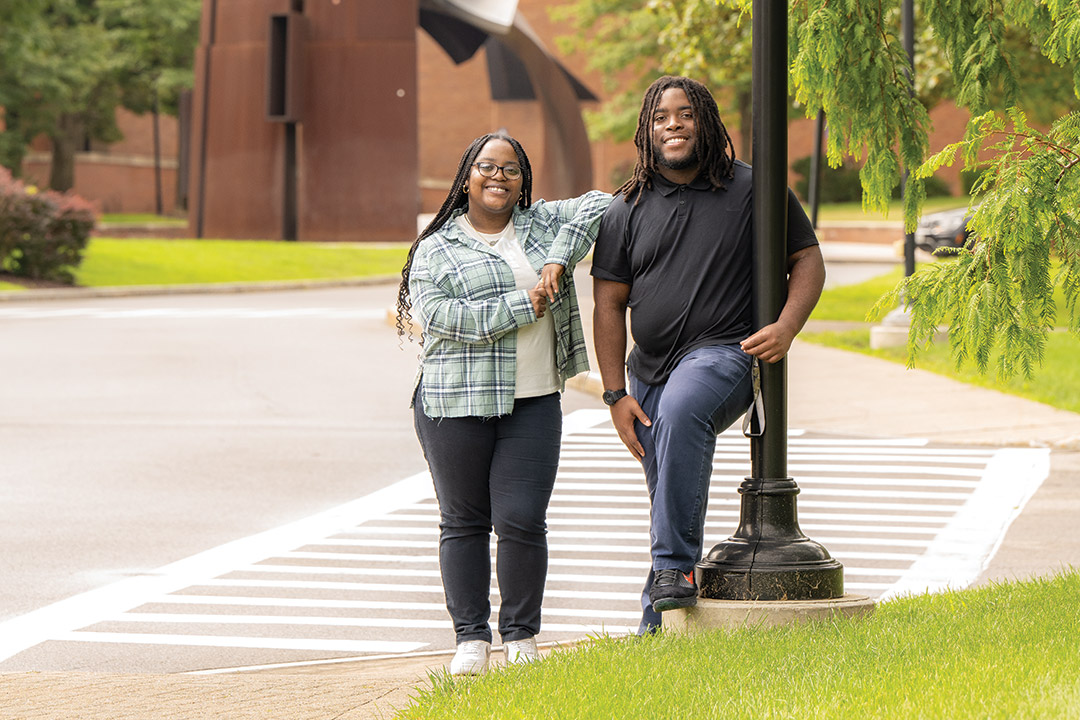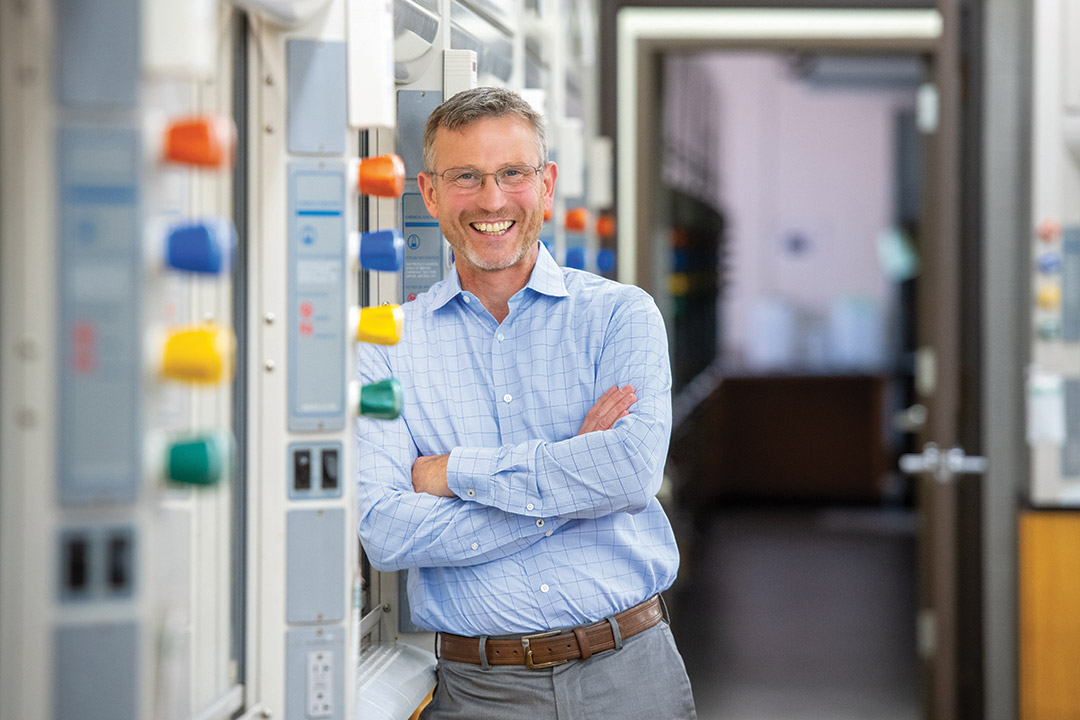Transformative Campaign propels university to new heights
Carlos Ortiz
TiasJah Terry, left, and her twin, TasJohn, are Destler/Johnson Rochester City Scholars, a program that provides full-tuition scholarships.
RIT student TasJohn Terry is designing and building a robotic arm that blends his interest and expertise in 3D printing. When he graduates, he wants to either attend graduate school or work for an automotive production company like Honda or Magna.
Meanwhile, his twin sister, TiasJah, is designing and personalizing her own packaging that will be manufactured into a physical package. She is on her way to landing her dream career as a packaging designer for Mattel in California.
Thanks, in part, to opportunities funded by the $1 billion Transforming RIT: The Campaign for Greatness, the students are engaged in active learning that propels their academic experience and fuels their passions, allowing for a comprehensive, robust RIT experience.
More than $200 million has been given to Transforming RIT to support scholarships and the student experience to ensure the best and brightest minds can attend RIT regardless of their financial circumstances. The campaign, launched publicly in 2018, is bringing RIT’s strategic plan to life by investing in student success, creating world-class facilities, advancing research and discovery, and innovating careers of the future.
From scholarships to professorships, programs to facilities, and research to mind-blowing innovation, the blended campaign received support from a wide variety of investors—alumni, parents, friends, government and corporate partners, research foundations, and agencies. The campaign surpassed the $1 billion goal—the largest fundraising effort in the university’s history—in March.
“We are grateful to each and every donor for propelling us forward,” said Phillip D. Castleberry, vice president for University Advancement. “Our ongoing success requires a community of supporters that helps us pursue our vision and deliver on our mission. Because of your generosity, we have successfully completed a truly transformative campaign that will have untold impact on our students and the campus.”
Both TasJohn and TiasJah are Destler/Johnson Rochester City Scholars, a program created by former RIT President Bill Destler and his spouse, Rebecca Johnson, that offers full-tuition scholarships for entering full-time, first-year students from public and charter schools within the Rochester City School District, as well those students participating in the Urban-Suburban Interdistrict Transfer Program.
The program has provided more than 300 high school graduates with the opportunity to attend RIT tuition-free—one clear example of how RIT is fulfilling its strategic plan of building partnerships within the local community.
“If I hadn’t received this scholarship, I would most likely have gone to a community college or trade school,” said TasJohn, a third-year electrical engineering technology major. “My high school counselor at Rochester Prep mentioned the scholarship to me. I’m extremely grateful. Without this, I can say that I wouldn’t have had the chance to attend a great institution like RIT. I can see myself and my future.”
A Chance to make a difference
With two RIT degrees, Chance Wright understands the student experience and wants to build upon what made RIT transformative for him.
That’s exactly why Chance Wright ’18 (advertising photography), ’19 (MBA) made gifts totaling $5.3 million toward significant renovations and expansions to RIT’s School of Photographic Arts and Sciences (SPAS) in the College of Art and Design (CAD) and Saunders College of Business.
“I received a first-rate education here at RIT, and it’s important to me to do all I can to make the university even more appealing to current and future students,” Wright said. “These gifts will enable the facilities inside SPAS and Saunders College to match the outstanding faculty and innovative students who will go on to change the world.”
A $3.5 million gift from Wright and his mother, Pamela Mars Wright—the largest single gift ever made to CAD— fueled the renovation and reconfiguration of the third floor of Gannett Hall, part of a multiyear master plan to renovate, rejuvenate, and transform spaces to meet the growing demand for a college that serves as RIT’s creative hub at the intersection of technology, the arts, and design.
His $1.8 million gift to Saunders College is helping fund renovations to existing facilities and a massive expansion, which will nearly double the building’s current footprint. Inspired by the latest technology and building features found in industry, Saunders College—with its additional 36,000 square feet—will better incorporate essential elements of applied learning and collaboration.
With two RIT degrees, Wright understands the student experience and wants to build upon what made RIT transformative for him, so that the university’s undergraduate and graduate students continue to receive the ever-evolving experience that he did.
“I want the facilities to do the same thing for students today that they did for me when I visited campus years ago,” Wright recalled.
Endowed professorships forge pathways
Carlos Ortiz
Gerald W. Harris Endowed Professor Emmett Ientilucci, left, takes his role as a mentor seriously, creating pathways for students like Dave Conrad, right, to become successful scientists.
In addition to direct scholarships to students and funding for new facilities, campaign funds created endowed professorships, providing the fuel for faculty to support student research and develop cutting-edge curricula.
In 2022, two new endowed professorships in the College of Science were established thanks to a $2 million gift from RIT Board of Trustees Chairperson Jeffrey Harris ’75 (photographic science and instrumentation) and his partner, Joyce Pratt.
Associate Professor Emmett Ientilucci, who now holds the Gerald W. Harris Endowed Professorship, believes that his role as a teacher and mentor is to forge pathways for his students to become successful scientists, advancing the body of knowledge and becoming strong contributors to the scientific landscape. Essentially, campaign dollars seed-fund their careers.
“I integrate students into everything I do in my classroom and research labs. Creating ways to encourage students to continue their research through offering essential stipends and funding experiential travel to national and global conferences, where they interact with the best scientists in the world, is essential to my mission,” said Ientilucci, graduate admissions chair for the Chester F. Carlson Center for Imaging Science and recipient of the 2020-2021 Richard and Virginia Eisenhart Provost’s Award for Excellence in Teaching at RIT. “My goal is to give students a sound education. Entering the real world is part one. Part two is making sure they’re ready for their next phases of life, beginning their careers, following their passions.”
To the average person, teaching the use of artificial intelligence (AI) and machine learning in the field of chemistry is a stretch. But according to Christopher Collison, professor in the School of Chemistry and Materials Science and the newly appointed Jane King Harris Endowed Professor, AI has “flipped the world on its head” and is accelerating finding solutions to problems, whether that’s research in diseases, solar cells, or sustainability.
Collison is using his professorship to purchase hardware, software, and computational tools to adapt chemistry programs to integrate AI. He believes that students who understand chemistry and materials science, and can incorporate the foundations of AI, will be ready to make major research contributions, going forward.
“This type of course doesn’t currently exist at the moment in chemistry,” said Collison, who hopes this will also lead to more external funding for the program. “But, we’re RIT. We can see ahead and build this for graduate chemistry students. The goal here is to train our students to always be ready for what’s next.”
Research growth helps fuel campaign
Carlos Ortiz
Jane King Harris Endowed Professor Christopher Collison is adapting RIT’s master’s in chemistry program to incorporate artificial intelligence.
Last year, increases in collaborative projects and inter-organizational engagements combined for a record $92 million in research funding for RIT, as the university exceeded $90 million for the first time ever.
RIT consistently grew its research footprint while maintaining a vibrant undergraduate experience. The university is now listed as a “high research activity institution” or “R2” under the updated Carnegie Classification of Institutions of Higher Learning—the second-highest classification and puts RIT among the top 6 percent of colleges and universities in the nation.
These increased awards in areas such as advancing biomedical technology and economic development initiatives lifted the university to the record year and played a significant role in helping RIT surpass the campaign goal.
RIT’s niche areas include nanotechnology, optics and imaging science, cybersecurity, and AI. In recent years since the campaign’s launch, many of the university’s awards were funded by national agencies like the National Science Foundation, the Department of Defense, National Institutes of Health, and both NASA and the Department of Energy.
“I’m pleased that our growing success played a key role during the campaign and is yet another sign of our maturity as a research university,” said Ryne Raffaelle, RIT vice president for Research and associate provost.
Government support also contributed significantly to the blended campaign, said Vanessa J. Herman, vice president for Government and Community Relations.
One example is MAGIC Spell Studios, which was funded, in part, by $12 million from New York state. With specialty spaces including a state-of-the-art sound stage and production facilities that rival those found in New York City or Los Angeles, MAGIC Spell Studios ties together entrepreneurship, academics, content creation, production, and distribution. Initiatives like these not only transform the RIT student experience, but also are a strategic investment in strengthening Western New York.
“Working together with our federal and state public officials was critical to the success of the campaign,” Herman said. “It’s a great example of public-private partnerships working toward a common goal to support our students and provide critical dollars to improve RIT’s infrastructure and add some amazing state-of-the-art labs and classroom space.”
The Terry twins would agree that the campaign has resulted in a better experience for all students.
“I think it’s important to thank our donors for investing in local students,” said TiasJah, a third-year packaging science major. “They could have looked anywhere for the most promising engineering students, the most promising science students, the most promising art students. But they chose to invest in students from Rochester and give me and my brother the opportunity to be part of RIT.”
Highlights of Transforming RIT: The Campaign for Greatness
The $1 billion campaign focused on investing in student success, creating world-class facilities, advancing research and discovery, and innovating careers of the future.
2013
- Transforming RIT: The Campaign for Greatness quiet phase begins. The goal of the blended campaign is to raise $1 billion.
- RIT receives $1.25 million from New York state to establish the Center for Urban Entrepreneurship in downtown Rochester.
- RIT receives $1.5 million from Juniper Networks for a new web application security framework, secured for use by the Golisano College of Computing and Information Sciences.
- RIT launches the Eugene H. Fram Chair in Applied Critical Thinking with a $1 million gift from an anonymous alumni donor.
2014
- Hockey’s new home, the Gene Polisseni Center, opens thanks in part to a $4.5 million partnership between the Polisseni Foundation and RIT Trustee Emeritus B. Thomas Golisano. Steve Schultz ’89 and Vicki Schultz ’92, ’94, ’99 kicked off the fundraising with a $1 million gift.
- RIT announces plans for the Wegmans School of Health and Nutrition, part of RIT’s College of Health Sciences and Technology, with a $6 million gift from The Wegman Family Charitable Foundation.
- RIT President Bill Destler and his spouse, Rebecca Johnson, give a $1 million endowment gift to the Rochester City Scholars program.
2015
- RIT announces the Bruce B. Bates Women’s Hockey Coach, the university’s first endowed coaching position, supported with a gift of $1.15 million by Trustee Emeritus Bates.
- RIT receives a 10-year designation to establish the AMPrint Center, a Center for Advanced Technology supported with over $920,000 in annual funding pledged by the state.
- The August Family Atrium in the Clinical Health Sciences Center in the College of Health Sciences and Technology is made possible by a donation from the Charles J. and Burton S. August Family Foundation.
2016
- Carnegie Classification of Institutions of Higher Education changes RIT from Masters-Comprehensive to Doctoral University.
- The Ann Mowris Mulligan Distinguished Professorship in the School for American Crafts is enhanced with a $1 million estate gift.
- With a philanthropic gift, RIT establishes the Harvey Palmer Professorship to honor the retiring dean for his stewardship of the Kate Gleason College of Engineering.
2017
- David C. Munson Jr. starts as RIT’s 10th president succeeding Bill Destler, who retired after 10 years.
- Austin McChord ’09 gives $50 million to RIT, the largest single donation ever made to the university. The gift goes toward building the Student Hall for Exploration and Development (SHED), creating the Gap Year Entrepreneurial Fellowship and the Student Accelerator Startup Endowed Fund, and establishing four endowments for professorships named after his former grade school teachers.
- Joseph M. Lobozzo II ends the Saunders College of Business Challenge with a $3 million gift. Lobozzo also gives $1.5 million to create the Joseph M. Lobozzo II Endowed Professorship.
- E. Philip Saunders provides the lead gift to establish the Daniel D. Tessoni Endowed Chair in Accounting and, with a $2 million gift, establishes the E. Philip Saunders Endowed Professorship in Saunders College of Business.
2018
- RIT publicly launches its $1 billion blended campaign during an evening of entertainment.
- RIT receives $1.5 million from Empire State Development to purchase machinery and equipment to support the Genomics Research Lab Cluster.
- Sudhakar “Bal” G. Dixit ’74 and Anita Dixit establish the Bal Dixit Laboratory for Advanced Materials and Fire Protection with a gift of $2 million.
- RIT opens MAGIC Spell Studios, made possible through state, corporate, and private funding, including $1.5 million from The Wegman Family Charitable Foundation.
- RIT sets a record of $78 million in research funding for the fiscal year.
- RIT receives a $1.3 million gift from Philip Wehrheim ’66 and his wife, Anne, to endow a partnership with Genesee Country Village & Museum.
- RIT receives $5 million for a global institute focused on cybersecurity from a grant through the New York State Higher Education Capital Matching Grant Program.
2019
- Chance Wright ’18,’19 makes a $3.5 million gift to the School of Photographic Arts and Sciences, the largest single gift ever made to the College of Art and Design.
- RIT is gifted a 177-acre estate by Amy Leenhouts Tait and Robert C. Tait. Tait Preserve will expand research and educational offerings.
- RIT moves up a Carnegie Classification among research universities to high research activity, or R2.
2020
- Carestream Health donates $1.2 million in ultrasound equipment to RIT.
- The Gleason Family Foundation surpasses $5 million of philanthropic support to promote experiential learning and hands-on education as well as faculty funding in the Kate Gleason College of Engineering.
- RIT’s new leadership annual giving program, Sentinel Society, launches. The program recognizes donors who give $1,000 or more annually over five years.
2021
- E. Philip Saunders; Chance Wright ’18, 2023 ’19; Susan Riedman Holliday ’85; the late Klaus Gueldenpfennig ’74, ’77; Brigitte Gueldenpfennig ’81; and Dinah Gueldenpfennig Weisberg ’97, ’03 collectively commit nearly $12 million toward an expansion of Saunders College of Business. Additional funds were awarded by New York State’s Higher Education Capital Matching Grant Program.
- Nippon Foundation awards NTID a $500,000 grant to support the education and employment of people who are deaf and hard of hearing in the Philippines and Vietnam.
- RIT is awarded a nearly $2 million grant by the National Science Foundation for AWARE-AI, which will create a research traineeship program to increase diversity in graduate students studying computing, engineering, psychology, imaging science, and mathematics.
2022
- Research funding surpasses $92 million in a fiscal year for the first time.
- ESL Federal Credit Union gifts $3 million to name the ESL Global Cybersecurity Institute.
- Trustee Frank Sklarsky ’78 and his wife, Ruth, give $2.5 million to establish the Sklarsky Glass Box Theater in the SHED.
- RIT receives $2 million from the U.S. Department of Commerce to update and expand its Semiconductor Fabrication Lab.
- James Hammer donates $1 million to establish the Hammer Family Packaging and Graphic Media Center.
- Jeffrey Harris ’75 and Joyce Pratt give $2 million to establish two new endowed professorships in the College of Science.
- RIT is awarded $2 million from the New York State Energy Research and Development Authority’s Carbon Neutral Community Economic Development Program to develop a net-zero energy/carbon roadmap in partnership with Rochester Regional Health.
- Doug May Field is dedicated, honoring the late men’s soccer coach. Family, alumni, and friends raised $1 million to name the field in memory of May.
2023
- RIT surpasses $1 billion goal with a gift from John Traver ’10 for an endowed professorship in the College of Art and Design.
- Onsemi donates $500,000 to further semiconductor educational initiatives and support projects and educational programming aimed at increasing the pipeline of engineers in the computer chip field.
- A $500,000 gift from Steve Wear ’91 will support the renamed Steven M. Wear Unmanned Aircraft Systems Laboratory and the Willem “Bill” Brouwer Endowed Fellowship.
- The Sentinel Society surpasses 500 founding members.












